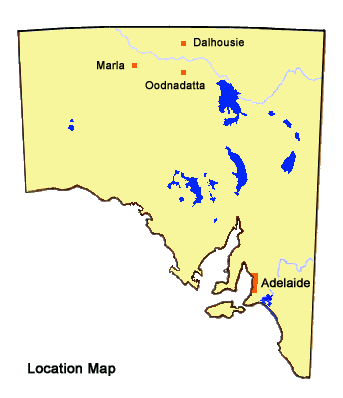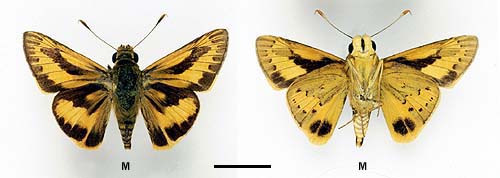-
Larval Food Host
-
Most species of palms (Palmae/Arecaceae), but the adult female prefers to
lay eggs on the palms with broad-leaf pinnae like
**Archontophoenix species (bangalow palm),
**Livistona spp (cabbage tree palms), and *Phoenix spp (date palms).
The larvae eat the leaves of the foodplant.
-
Eggs
-
Large, domal or hemispherical shaped, base flat circular, pale yellow when newly laid,
but after 2 days if fertile the eggs acquire a narrow pinkish red lateral band and
a similarly coloured micropylar area. Eggs turn white and pink near hatching.
The small micropylar area on top of the egg is depressed, the upper part of the
egg surface has a very fine indistinct raised polygonal pattern, while the
lower part has indistinct, very fine vertical ridges. The base is rimmed. Laid
singly either above or beneath the leaf pinnae situated on the outer parts of the palm
frond, although more than one egg may occur on the pinnae due to successive laying.
The egg shell is eaten by the larva after its emergence.
-
Larvae
-
The first instar is long cylindrical, initially pale yellow, but turning a semi-translucent
greenish colour after eating the foodplant. The head is rounded, large, shining black having
a few hairs, and the neck (prothoracic plate) is transparent. There are a few short hairs
along the body and long recurved hairs occur posteriorly. After eating the empty eggshell
the larva will move to near the tips of the leaves to form an open ended shelter, which it
does by either folding over a tip portion of a single leaf pinnae to make a small tubular
shelter (by joining the edges together by distinct cross strands of silk causing a zebra-like
stitch pattern), or more often it will silk two leaves together on top of each other to make
a flat shelter.
Subsequent immature instars are semi-translucent pale green or greenish white coloured
and lose the body hairs. Sometimes the second instar in a torpid state will be pinkish
brown coloured with the posterior end remaining pale yellow. The head becomes finely
rugose and eventually by about the fourth instar, acquires the head pattern described
for the final instar larva. The shelters become progressively larger, which are either
made by folding over individual pinnae to make a tubular shelter or by silking two leaves
together on top of each other to make a flat shelter. They are silked strongly together
by individual strands of silk. The larvae feed at night and rest inside the shelters
during the day, usually with their heads pointing towards the tip of the pinnae. They eat
the edges of the pinnae, and where the skipper is prolific have the potential to skeletonise
the palm fronds.
The final instar is about 40-45 mm, long cylindrical shaped, with the last posterior segment
flattened into the anal plate, smooth, but with the posterior end having some hairs. The body
is semi-translucent pale green or greenish white coloured, but sometimes they are pinkish or
purplish, or even bluish, with a darker longitudinal dorsal line, and the posterior end is
yellowish. The head is large, rounded, slightly rugose, white or pale yellow coloured, marked
with dark brown,vertical central and lateral lines.
The presence of larvae on a frond is discernible by large jagged eat marks at the edges of
the pinnae and by the webbed overlapping of pinnae to make the flat larval shelters.
-
Pupae
-
Long cylindrical, about26 mm long, semi-translucent pale green or greenish white to brown
coloured, nearly smooth, heavily covered in a white powdery bloom, the latter acting as
a water repellent and perhaps fungicide. Covered with short, stiff, white spinose bristles
on the abdomen, dorsal parts of the thorax, and the head. The posterior end tapers to a
very short cremaster ridge and long attachment bristles, which the pupa uses to anchor
itself to the silk cocoon. The head is rounded, with the head cap (operculum) being pale
coloured and hairy. The ventral proboscis significantly extends posterior of the wing
cases as a loose extension, a feature that typifies the members of the Hesperiinae subfamily.
Pupation usually occurs in the final larva shelter on the foodplant, but sometimes larvae
will leave the foodplant to pupate, which is probably a good move if there are many larvae
present on the palm frond. The final larval shelter is similar to the previous shelters,
except that in this shelter the larva weaves a strong inner silken cocoon sealed off at
one end, while the other end (the entrance and usually pointing towards the pinnae tip)
is sealed off with silken cross threads before pupation. The sealed entrance helps to
prevent predators from entering the shelter and also helps keep the pupa secure within
the shelter during periods of strong winds. The silk sealing strands at the shelter
entrance have to be broken by the emerging adult. The pupal duration is variable, even
during the same time of the year. The empty pupal case remains inside the shelter after
the adult skipper emerges.
-
Flight Period in South Australia
-
This skipper flies all year round in the northern tropical areas.

-
Distribution
-
The skipper has yet to be recorded from South Australia and native palms do not occur
naturally in SA. There have been several attempts to grow date palms in the Flinders Ranges,
and the Far North Region particularly at Dalhousie, and ornamental palms are grown
in major towns in the Far North at Marla and Oodnadatta, and it is possible that
this skipper may accidentally be introduced to these palms in the future. However,
the skipper was not seen at any of these localities during recent surveys (2001-2004)
and it is likely either the winters are too cold or the localities are too isolated for
this skipper to accidentally establish. The skipper is known from the Alice Springs area.
It is possible this skipper may accidentally be introduced to the more climatically
suitable Adelaide (as happened in Perth) sometime in the future (if not already present).

-
Habitat
-
In northern Australia this skipper normally occurs in the hot tropical, coastal and
subcoastal moist woodlands where its palm hostplants occur naturally. It has now
adjusted to coastal urban areas wherever palms are growing in a high enough density.
It is doubtful if it can survive in temperate areas unless it can access warm sheltered
conditions such as might be found in the larger cities. It does not seem to be as cold
tolerant as C. augiades.
-
Conservation Status in South Australia
-
A common species in northern tropical Australia wherever palms are growing in adequate density.
-
Threats
-
In northern areas of Australia the main threat is from the annual winter burnoff.
-
Conservation Strategy
-
None required.


